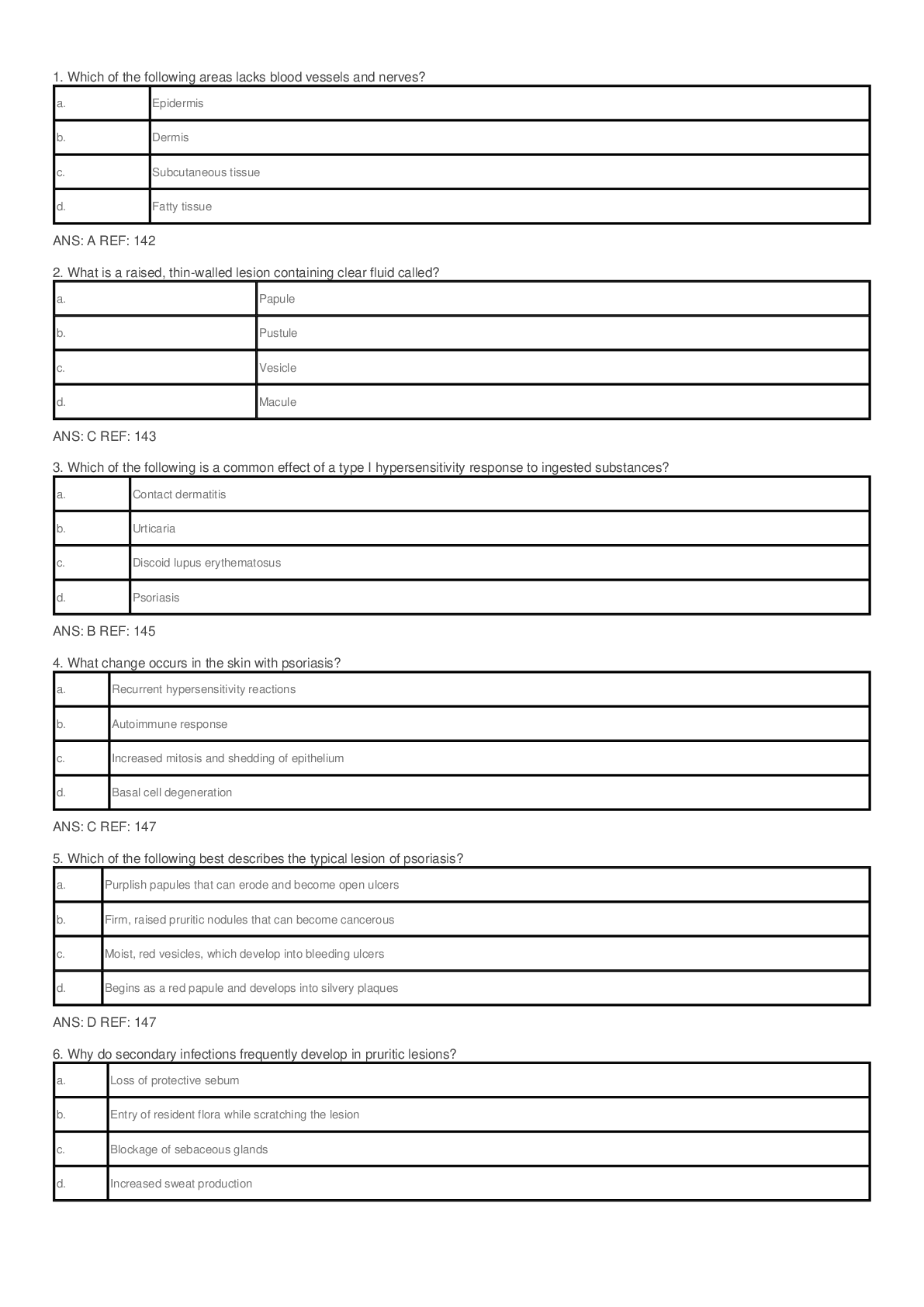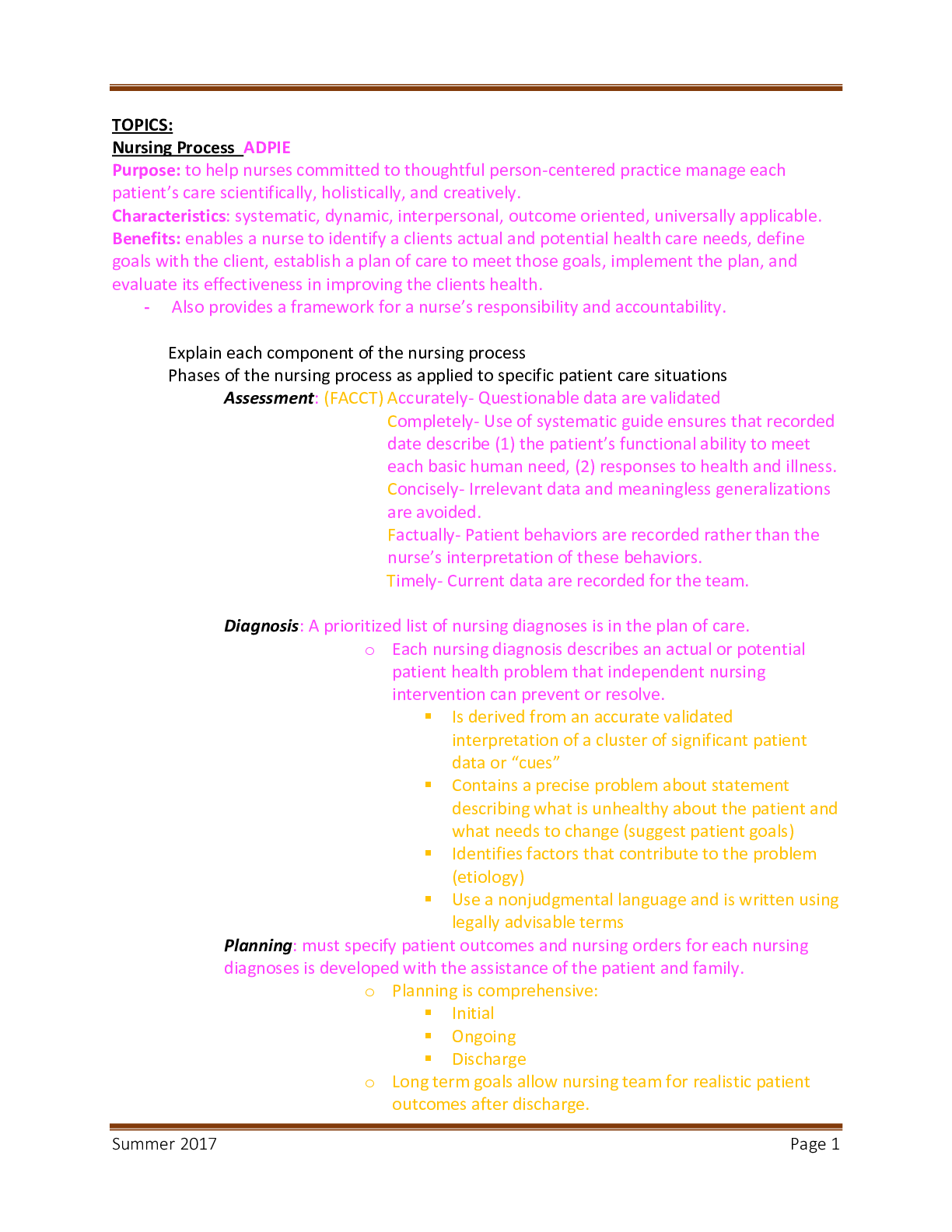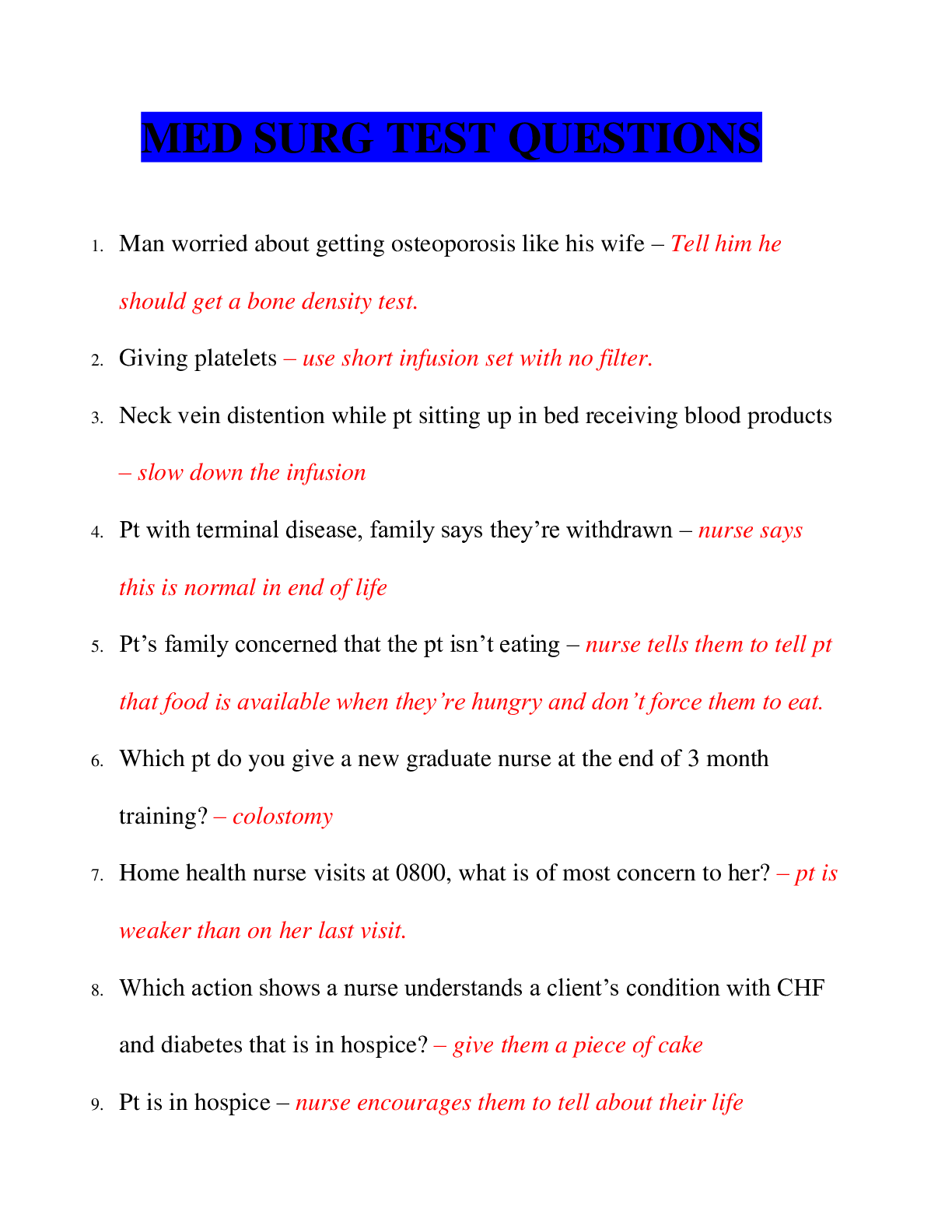*NURSING > QUESTIONS & ANSWERS > PCM Exam 2, Questions and answers, 2022 update version, Graded A+ (All)
PCM Exam 2, Questions and answers, 2022 update version, Graded A+
Document Content and Description Below
PCM Exam 2, Questions and answers, 2022 update version, Graded A+ Proper seat depth can be determined by: A. Placing 2 or 3 fingers between the front edge of the seat and the patient's poplite... al fold (your hand parallel to the floor).. B. Placing your hand vertically between the patient's greater trochanter or hip and the armrest panel. C. Placing 4 fingers between the front edge of the seat and the patient's popliteal fold D. Placing your hand horizontal between the patient's greater trochanter or hip and the armrest panel. - ✔✔A. Placing 2 or 3 fingers between the front edge of the seat and the patient's popliteal fold (your hand parallel to the floor).. To elevate the casters of a wheelchair while assisting a patient the therapist will need to: A. stand beside the patient and the wheelchair. B. push down and forward on a tipping lever while pushing down and back on the push handles. C. push down and forward on the push handles while pushing down and back on a tipping lever. D. ask the patient to lean back to help with elevating. - ✔✔B. push down and forward on a tipping lever while pushing down and back on the push handles. When assisting a patient in a wheelchair up the stairs, the assistants at the front of the wheelchair should grasp the: a. Legrests b. Armrests c. Chair frame d. Cross bar - ✔✔c. Chair frame When helping a patient descend stairs in a wheelchair the wheelchair should be A. tilted on the caster wheels. B. tilted on the drive wheels. C. positioned with all four wheel on the level surface. D. remain level at all times. - ✔✔B. tilted on the drive wheels. https://www.youtube.com/watch?v=zns0e3m3CEg In addition, caster wheels are elevated. When taking a patient up a curb in a w/c which of the following is CORRECT: a. When approaching the curb with the wheelchair backwards the caster wheels are the last to come off the ground b. When approaching the curb with the wheelchair backwards the chair should already be in a "wheelie" position with the caster wheels off the ground c. When approaching the curb with the wheelchair forwards the caster wheels are the last to come off the ground d. When approaching the curb with the wheelchair forwards the drive wheels should be off the ground - ✔✔b. When approaching the curb with the wheelchair backwards the chair should already be in a "wheelie" position with the caster wheels off the ground Which of the following is the best way for a wheelchair user to negotiate very steep slopes? a. Go up the slope using a zigzagging path. b. Have someone pull the chair up the slope backward. c. Tip the chair into a wheelie position and go up the slope backward d. Tip the chair into a wheelie position and go up the slope forward. - ✔✔a. Go up the slope using a zigzagging path. Elevation of caster wheels by the patient A. should only be attempted if the patient has sufficient upper extremity strength and coordination and be able to maintain sitting balance. B. should never be attempted by a patient alone. C. is easy and should not require much practice. D. None of the above - ✔✔A. should only be attempted if the patient has sufficient upper extremity strength and coordination and be able to maintain sitting balance. How should a patient using both upper extremities for wheelchair propulsion be taught to navigate up a particularly steep ramp or incline? a. Facing forward, moving in a straight line b. Facing backward, moving in a straight line c. Facing forward, moving in a zigzag fashion d. Facing backward, moving in a zigzag fashion - ✔✔c. Facing forward, moving in a zigzag fashion The easiest and safest way to assist a patient descending a curb while in a wheelchair is a. forward facing while tilting the chair up on the caster wheels. b. in the backward position while tilting the chair up on the caster wheels. c. forward facing while tilting the chair up on the drive wheels. d. in the backward position while tilting the chair up on the drive wheels. - ✔✔d. in the backward position while tilting the chair up on the drive wheels. When assisting a patient to ascend a curb while in a wheelchair: A. the therapist can assist facing forward or backward. B. the therapist should only assist going forward. C. the therapist should only assist going backward. D. the therapist does not need to tip the chair when going backward. - ✔✔A. The therapist can assist facing forward or backward. After performing your muscle test, you find that your patient has no strength (0/5) in their legs and 4/5 strength in their arms. You would initially use the: a. sliding board transfer b. standing dependent pivot transfer c. standing assisted pivot transfer d. lateral swing transfer - ✔✔a. sliding board transfer You are performing a manual muscle test for shoulder flexion and the patient is able to lift their arm 75% through the range of motion while standing. No resistance is given. What muscle grade would you give? a. 2/5 b. 3-/5 c. 3+/5 d. 4/5 - ✔✔b. 3-/5 When a patient is able to do 25% to 49% of a transfer they are considered to require: a. Maximum assistance b. Moderate assistance c. Minimal assistance d. Dependent - ✔✔a. Maximum assistance As a clinician, you decide to complete a standing dependent pivot transfer with a patient. You are expecting to provide ___________ assistance. a. minimal b. moderate c. maximal d. total - ✔✔c. maximal Which of the following is true regarding the head/hips relationship? a. It is a key component of the standing transfers b. It is used to transfer when there is sufficient strength in the legs c. It does not require the therapist to block the patients legs d. Where the patient swings their head their hips go opposite - ✔✔d. Where the patient swings their head their hips go opposite Which of the following is true regarding transferring a patient status post THR? a. Instruct them to pivot on their LEs when moving from the wheelchair to the bed b. Instruct them to lead with their hips when coming to stand c. Have them lean their trunk forward so they can shift their weight over their feet d. The bed should be slightly lowered so they don't have to stand up as much - ✔✔b. Instruct them to lead with their hips when coming to stand It is best practice to give verbal instructions and demonstrate a transfer to the patient prior to starting the transfer. What is the best way to give the verbal instructions. a. concise terminology with action oriented verbage. b. One word commands. c. Detailing each step from start to beginning d. Sing the directions so they are able to remember and repeat - ✔✔a. concise terminology with action oriented verbage. During a standing, assisted pivot transfer, where should a caregiver's left leg be placed if the patient has significant right knee weakness? a. Posterior to the weak knee b. Anterior to the weak knee c. Lateral to the weak knee d. Near the patient's stronger side - ✔✔b. Anterior to the weak knee In standing from a seated position, how should the patient's feet be positioned if one is significantly weaker than the other? a. With the stronger foot posterior to the weaker foot b. With the weaker foot posterior to the stronger foot c. They should be positioned level with each other, less than a shoulder width apart d. They should be positioned level with each other, more than a shoulder width apart - ✔✔a. With the stronger foot posterior to the weaker foot If a patient is transferring to the right from a wheelchair to bed, where should the buttocks be positioned before the transfer? a. In the middle of the wheelchair seat b. Toward the back of the wheelchair seat, behind the drive wheel c. To the right side of the wheelchair seat, behind the drive wheel d. Toward the front of the wheelchair seat, in front of the drive wheel - ✔✔d. Toward the front of the wheelchair seat, in front of the drive wheel Standard adjustable bed advantage A. bed can be operated by the patient B. allows access to a patient for a variety of therapeutic interventions C. reduces the need to apply topical medications by establishing a microclimate environment that promotes healing, can help with burns d. Side to side motion improves upper respiratory tract function. Decrease urinary stasis and increase BM function e. can be adjusted to accommodate the need to change a position and can be altered through electronic operated controls - ✔✔A. bed can be operated by the patient Turning frame bed (Stryker wedge frame) advantage A. bed can be operated by the patient B. allows access to a patient for a variety of therapeutic interventions C. reduces the need to apply topical medications by establishing a microclimate environment that promotes healing, can help with burns d. Side to side motion improves upper respiratory tract function. Decrease urinary stasis and increase BM function e. can be adjusted to accommodate the need to change a position and can be altered through electronic operated controls - ✔✔B. allows access to a patient for a variety of therapeutic interventions Air-fluidized support bed advantages A. bed can be operated by the patient B. allows access to a patient for a variety of therapeutic interventions C. reduces the need to apply topical medications by establishing a microclimate environment that promotes healing, can help with burns d. Side to side motion improves upper respiratory tract function. Decrease urinary stasis and increase BM function e. can be adjusted to accommodate the need to change a position and can be altered through electronic operated controls - ✔✔C. reduces the need to apply topical medications by establishing a microclimate environment that promotes healing, can help with burns Post-trauma mobility bed advantages A. bed can be operated by the patient B. allows access to a patient for a variety of therapeutic interventions C. reduces the need to apply topical medications by establishing a microclimate environment that promotes healing, can help with burns d. Side to side motion improves upper respiratory tract function. Decrease urinary stasis and increase BM function e. can be adjusted to accommodate the need to change a position and can be altered through electronic operated controls - ✔✔d. Side to side motion improves upper respiratory tract function. Decrease urinary stasis and increase BM function Low air loss therapy bed A. bed can be operated by the patient B. allows access to a patient for a variety of therapeutic interventions C. reduces the need to apply topical medications by establishing a microclimate environment that promotes healing, can help with burns d. Side to side motion improves upper respiratory tract function. Decrease urinary stasis and increase BM function e. can be adjusted to accommodate the need to change a position and can be altered through electronic operated controls - ✔✔e. can be adjusted to accommodate the need to change a position and can be altered through electronic operated controls Disadvantage of standard adjustable bed a. side rails can accidentally compress IV units b. patient can only be in supine or prone positions, Decrease PVC in quadriplegic c. cover of the bed can be easily damaged, uncomfortable for obese and small people, body fluids evaporate quick d. air bladders can be punctured or torn by sharp objects. and frequent alterations of the patients position must be performed to prevent pressure ulcers e. can cause motion sickness, pts may feel isolated - ✔✔a. side rails can accidentally compress IV units Disadvantage of turning frame bed (Stryker wedge frame) a. side rails can accidentally compress IV units b. patient can only be in supine or prone positions, Decrease PVC in quadriplegic c. cover of the bed can be easily damaged, uncomfortable for obese and small people, body fluids evaporate quick d. air bladders can be punctured or torn by sharp objects. and frequent alterations of the patients position must be performed to prevent pressure ulcers e. can cause motion sickness, pts may feel isolated - ✔✔b. patient can only be in supine or prone positions, decreases PVC (premature ventricular contraction) in quadriplegic Disadvantage of air-fluidized support bed (clinitron) a. side rails can accidentally compress IV units b. patient can only be in supine or prone positions, Decrease PVC in quadriplegic c. cover of the bed can be easily damaged, uncomfortable for obese and small people, body fluids evaporate quick d. air bladders can be punctured or torn by sharp objects. and frequent alterations of the patients position must be performed to prevent pressure ulcers e. can cause motion sickness, pts may feel isolated - ✔✔c. cover of the bed can be easily damaged, uncomfortable for obese and small people, body fluids evaporate quick Disadvantage of post-trauma mobility bed a. side rails can accidentally compress IV units b. patient can only be in supine or prone positions, Decrease PVC in quadriplegic c. cover of the bed can be easily damaged, uncomfortable for obese and small people, body fluids evaporate quick d. air bladders can be punctured or torn by sharp objects. and frequent alterations of the patients position must be performed to prevent pressure ulcers e. can cause motion sickness, pts may feel isolated - ✔✔e. can cause motion sickness, pts may feel isolated Disadvantage of low air loss therapy bed. a. side rails can accidentally compress IV units b. patient can only be in supine or prone positions, Decrease PVC in quadriplegic c. cover of the bed can be easily damaged, uncomfortable for obese and small people, body fluids evaporate quick d. air bladders can be punctured or torn by sharp objects. and frequent alterations of the patients position must be performed to prevent pressure ulcers e. can cause motion sickness, pts may feel isolated - ✔✔d. air bladders can be punctured or torn by sharp objects. and frequent alterations of the patients position must be performed to prevent pressure ulcers What type of bed should be used when... - skeletal stability is desired - patient needs to be turned from prone to supine (vv) - patient must be immobilized after a spinal fracture - patient needs skeletal cervical traction a. Standard adjustable bed b. Air-fluidized support bed (clinitron) c. Turning frame (Stryker Wedge Frame) d. Post-trauma mobility bed (Keane, Roto-Rest) e. Low-air loss therapy bed - ✔✔c. Turning frame (Stryker Wedge Frame) What type of bed should be used for patients who... - have lesions, burns, pressure ulcers, and skin grafts - need skin protection - need prolonged immobilization a. Standard adjustable bed b. Turning frame (Stryker Wedge Frame) c. Air-fluidized support bed (clinitron) d. Post-trauma mobility bed (Keane, Roto-Rest) e. Low-air loss therapy bed - ✔✔c. Air-fluidized support bed (clinitron) What type of bed can... [Show More]
Last updated: 1 year ago
Preview 1 out of 29 pages

Buy this document to get the full access instantly
Instant Download Access after purchase
Add to cartInstant download
We Accept:

Reviews( 0 )
$12.00
Document information
Connected school, study & course
About the document
Uploaded On
Aug 22, 2022
Number of pages
29
Written in
Additional information
This document has been written for:
Uploaded
Aug 22, 2022
Downloads
0
Views
98

























